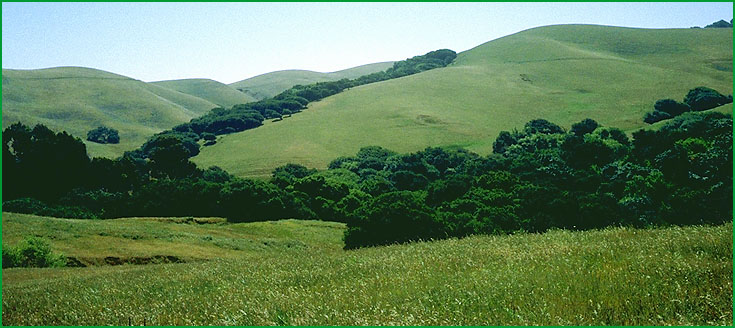 | Suisun Hills and Valleys |
northeast of Vallejo Ś Charles B. Goudey |
from http://www.fs.fed.us/r5/projects/ecoregions/261aa.htm
This subsection is an area of low hills north and south of the Carquinez Strait, and includes valleys between the hills, and plains at the west end of the Sacramento-San Joaquin River delta. The climate is hot and subhumid. It is very windy on hills adjacent to and north of the Carquinez Straight. MLRAs 14d and 15d.
Lithology and Stratigraphy. This subsection contains mostly Cretaceous, Eocene, and Miocene marine sedimentary rocks and late Quaternary alluvium, and minor amounts of Pliocene nonmarine sediments and volcanic rocks. The Franklin fault separates Cretaceous and Eocene marine sedimentary rocks in this subsection from Miocene sedimentary and volcanic rocks on the southwest.
Geomorphology. This is an area of steep to moderately steep hills, valleys between the hills, and the edge of a plain that is the floor of the Great Valley. The hills are aligned northwest. The subsection elevation ranges from sea-level up to 1428 feet in the Briones Hills. Mass wasting and fluvial erosion loss are the main geomorphic processes. Fluvial deposition is an important process on recent floodplain and alluvial fans, but most of the stream sediments are washed across the alluvial plain to estuaries of the San Francisco-San Pablo Bay system.
Soils. The soils on hills are mostly Lithic Xerochrepts, Typic Haploxeralfs, and Typic Argixerolls. Chromoxererts are common on moderately steep slopes. Soils on dissected Pliocene and Quaternary nonmarine deposits that are less extensive than those on hills are, in addition to Chromoxererts, Calcixerollic Xerochrepts, Calcic Haploxerolls, Typic Palexeralfs, and Chromic Pelloxererts. Soils on late Quaternary alluvial plains are mainly Typic and Mollic Haploxeralfs, Typic and Chromic Pelloxererts, and Aquic Natrixeralfs. Most, but not all, of the soils on hills are leached free of carbonates, but calcium carbonates accumulate in many soils on alluvial plains and more soluble salts accumulated in somewhat poorly drained soil. Soil temperature regimes are thermic (nearly mesic). Soil moisture regimes are mostly xeric with some aquic.
Vegetation. The predominant natural plant communities are Needlegrass grasslands and Blue oak series. On the hills north of the Carquinez Straight it is mostly too windy for trees to survive, particularly on west-facing slopes and summits. Coast live oak series is the predominant natural plant community in most of the Briones Hills. Valley oak series is common on alluvial plains.
Characteristic series by lifeform include:
Grasslands: California annual grassland series, Purple needlegrass series.
Shrublands: Coyote brush series.
Forests and woodlands: Blue oak series, Coast live oak series, Valley oak series.
Climate. The mean annual precipitation is about 15 to 20 inches. It is practically all rain. Mean annual temperature is about 56░ to 60░ F. The mean freeze-free period is about 250 to 275 days.
Surface Water. Runoff is rapid from hills, but slow across alluvial plains. All but the larger streams are dry through most of the summer. Natural lakes are absent.
